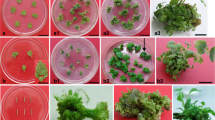Abstract
The goals of this study were to investigate thidiazuron (TDZ)-induced morphogenesis of Echinacea purpurea L. and to assess the possibility of developing a liquid-based protocol for rapid micropropagation. Callus development and root organogenesis were observed on leaf explants cultured on media containing 2,4-dicholorophenoxyacetic acid or dicamba, but no plantlets were regenerated. Addition of TDZ to the culture medium as the sole growth regulator resulted in the production of regenerable callus cultures. The highest rate of regeneration was observed for explants cultured on medium with TDZ at 2.5 μM or higher. Tissue derived from 1.0 μM TDZ treatments was used to initiate liquid cultures. All liquid treatments produced a similar number of regenerants but significantly more healthy plants were obtained from cultures grown in the presence of 0.1 and 1.0 μM TDZ. This TDZ-based micropropagation system is the first liquid, large-scale propagation protocol developed for the mass production of E. purpurea plants.






Similar content being viewed by others
Abbreviations
- 2,4-D:
-
2,4-dicholorophenoxyacetic
- DC:
-
dicamba
- TDZ:
-
thidiazuron
References
Annadana S, Radamaker W, Rammana M, Udayakumar M, de Jong J (2000) Response of stem explants to screening and explant source as a basis for methodical advancing regeneration protocols for chrysanthemum. Plant Cell Tissue Organ Cult 62:47–55
Barnes PM, Powell-Griner E, Mcfann K, Nahin RL (2004) Complementary and alternative medicine use among adults: United States, 2002. Vital Health Stat 343:1–20
Binns SE, Arnason JT, Baum BR (2002) Phytochemical variation within populations of Echinacea angustifolia (Asteraceae). Biochem Syst Ecol 30:837–854
Cabasson C, Alvard D, Dambier D, Ollitrault P, Teisson C (1997) Improvement in Citrus somatic embryo development by temporary immersion. Plant Cell Tissue Organ Cult 50:33–37
Canada Gazette (2003) Natural Health Products Regulations 137:SOR/2003-196
Chae WB, Choi GW, Chung IS (2004) Plant regeneration depending on explant type in Chrysanthemum coronarium L. J Plant Biotech 6:253–258
Choffe KL, Victor JMR, Murch SJ, Saxena PK (2000) In vitro regeneration of Echinacea purpurea L.: direct somatic embryogenesis and indirect shoot organogenesis in petiole culture. In Vitro Cell Dev Biol 36:30–36
Choffe KL, Murch SJ, Saxena PK (2001) Regeneration of Echinacea purpurea: induction of root organogenesis from hypocotyls and cotyledon explants. Plant Cell Tissue Organ Cult 62:227–234
Fugh-Berman A (2003) Echinacea for the prevention and treatment of upper respiratory infections. Semin Integr Med 1:106–111
Gamborg OL, Miller RA, Ojima K (1968) Nutrient requirements of suspension cultures of soybean root cells. Exp Cell Res 50:151–158
Grimm W, Muller H (1999) A randomized controlled trial of the effect of fluid extract of Echinacea purpurea on the incidence and severity of colds and respiratory infections. Am J Med 106:138–143
Gubiš J, Lajchová Z, Faragó J, Jureková Z (2003) Effect of genotype and explant type on shoot regeneration in tomato (Lycopersicon esculentum Mill.) in vitro. Czech J Genet Plant Breed 39:9–14
Hutchinson MJ, KrishnaRaj S, Saxena PK (1997) Inhibitory effect of GA3 on the development of thidiazuron-induced somatic embryogenesis in geranium (Pelargonium x hortorum Bailey) hypocotyl cultures. Plant Cell Rep 16:435–438
Koroch AR, Juliani HR, Kapteyn J, Simon JE (2001) In vitro regeneration of Echinacea purpurea from leaf explants. Plant Cell Tissue Organ Cult 69:79–83
Lakshmanan P, Danesh M, Taji A (2002) Production of four commercially cultivated Echinacea species by different methods of in vitro regeneration. J Hortic Sci Biotech 77:158–163
Mechanda SM, Baum BR, Johnson DA, Arnason JT (2003) Direct shoot regeneration from leaf segments of mature plants of Echinacea purpurea (L.) Moench. In Vitro Cell Dev Biol 39:505–509
Miller A (2000) Echinacea 2000: Technical crop report. Richters The Herb Specialists. Goodwood, ON, Canada, pp 1–17
Mithila J, Hall JC, Victor JMR, Saxena PK (2003) Thidiazuron induces shoot organogenesis at low concentrations and somatic embryogenesis at high concentrations on leaf and petiole explants of African violet (Saintpaulia ionantha Wendl.). Plant Cell Rep 21:408–414
Murashige T, Skoog F (1962) A revised medium for rapid growth and bioassays with tobacco tissue cultures. Physiol Plant 15:473–497
Murch SJ, Peiris SE, Shi WL, Zobayed SMA, Saxena PK (2006) Genetic diversity in seed populations of Echinacea purpurea controls the capacity for regeneration, route of morphogenesis and phytochemical composition. Plant Cell Rep 25:522–532
Murthy BNS, Murch SJ, Saxena PK (1995) Thidiazuron-induced somatic embryogenesis in intact seedlings of peanut (Arachis hypogaea): Endogenous growth regulator levels and significance of cotyledons. Physiol Plant 94:268–276
Murthy BNS, Murch SJ, Saxena PK (1998) Thidiazuron: A potent regulator of in vitro plant morphogenesis. In Vitro Cell Dev Biol 34:267–275
Percival SS (2000) Use of Echinacea in medicine. Biochem Pharmacol 60:155–158
Visser C, Qureshi JA, Gill R, Saxena PK (1992) Morphoregulatory role of thidiazuron: substitution of auxin-cytokinin requirement of somatic embryogenesis in hypocotyl cultures of geranium. Plant Physiol 99:1704–1707
Wills RBH, Stuart DL (1999) Alkylamide and cichoric acid levels in Echinacea purpurea grown in Australia. Food Chem 67:385–388
Ziv M (2000) Bioreactor technology for plant micropropagation. Hortic Rev 24:1–31
Zobayed SMA, Saxena PK (2003) In vitro regeneration of Echinacea purpurea L.: Enhancement of somatic embryogenesis by indolebutyric acid and dark pre-incubation. In Vitro Cell Dev Biol 39:605–612
Acknowledgments
The financial contributions from the Natural Science and Engineering Research Council of Canada and Science-Based Medicinal Plants Inc., Dundas, Ontario are gratefully acknowledged.
Author information
Authors and Affiliations
Corresponding author
Additional information
Communicated by P. Ozias-Akins
Rights and permissions
About this article
Cite this article
Jones, M.P.A., Yi, Z., Murch, S.J. et al. Thidiazuron-induced regeneration of Echinacea purpurea L.: Micropropagation in solid and liquid culture systems. Plant Cell Rep 26, 13–19 (2007). https://doi.org/10.1007/s00299-006-0209-3
Received:
Revised:
Accepted:
Published:
Issue Date:
DOI: https://doi.org/10.1007/s00299-006-0209-3




